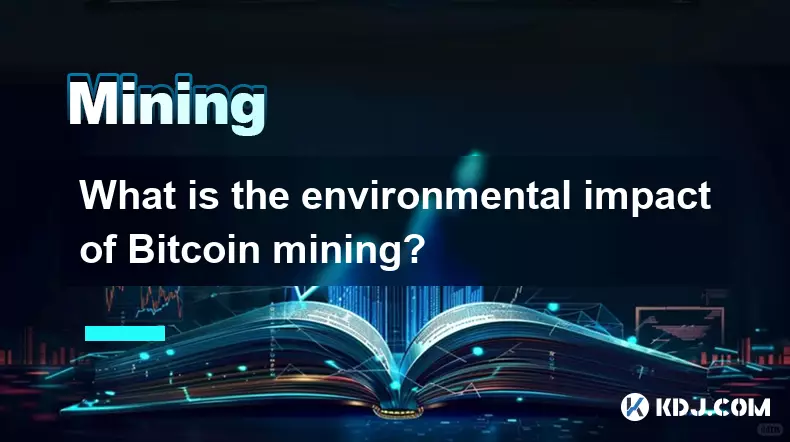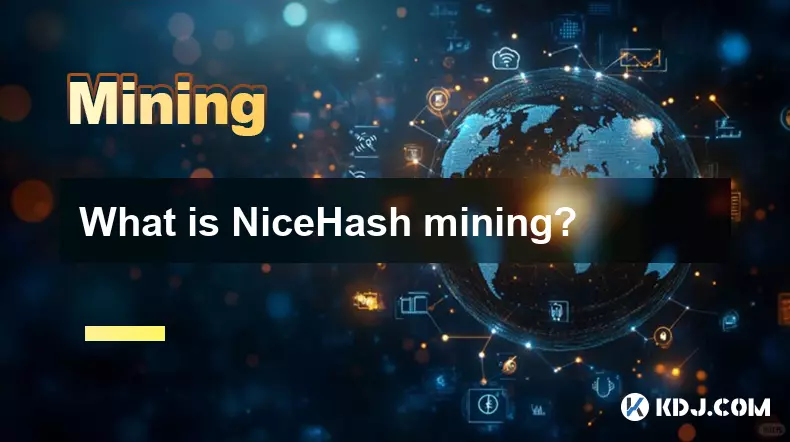-
 bitcoin
bitcoin $100977.009184 USD
-2.05% -
 ethereum
ethereum $3282.009150 USD
-3.23% -
 tether
tether $0.999813 USD
-0.02% -
 xrp
xrp $2.208254 USD
-4.89% -
 bnb
bnb $951.411089 USD
0.55% -
 solana
solana $155.761205 USD
-2.84% -
 usd-coin
usd-coin $1.000217 USD
0.02% -
 tron
tron $0.284475 USD
-1.28% -
 dogecoin
dogecoin $0.162363 USD
-1.53% -
 cardano
cardano $0.533988 USD
-0.47% -
 hyperliquid
hyperliquid $39.174339 USD
-3.22% -
 chainlink
chainlink $14.724828 USD
-1.16% -
 bitcoin-cash
bitcoin-cash $477.297986 USD
-1.28% -
 zcash
zcash $554.227426 USD
17.30% -
 ethena-usde
ethena-usde $0.998995 USD
-0.03%
What is the environmental impact of Bitcoin mining?
Bitcoin mining’s massive energy use and e-waste generation highlight the need for greater renewable adoption and sustainable practices in the crypto industry.
Nov 05, 2025 at 06:35 pm

Energy Consumption of Bitcoin Mining
1. Bitcoin mining relies on a proof-of-work consensus mechanism that demands substantial computational power. Miners operate high-performance hardware to solve complex cryptographic puzzles, consuming vast amounts of electricity in the process. The energy required to maintain the network scales with the total hash rate, which has consistently increased over time.
2. Studies estimate that the annual electricity consumption of the Bitcoin network rivals that of small countries. For instance, the Cambridge Bitcoin Electricity Consumption Index suggests its usage exceeds that of nations like Belgium or Sweden. This level of demand raises concerns about sustainability and strain on regional power grids.
3. The geographic distribution of mining operations influences energy sources. In regions where coal dominates the energy mix, such as parts of China prior to regulatory crackdowns, Bitcoin mining contributed significantly to carbon emissions. Conversely, areas with surplus hydroelectric or geothermal power offer cleaner alternatives.
4. Data centers dedicated to mining are often located in colder climates to reduce cooling costs, but this does not mitigate the core issue of electricity sourcing. Even efficient thermal management cannot offset the environmental toll if fossil fuels remain the primary energy input.
5. The sheer scale of energy use underscores the urgency for transparency in energy sourcing and adoption of renewable infrastructure within the mining sector.
Electronic Waste Generation
1. Mining hardware, particularly ASICs (Application-Specific Integrated Circuits), has a limited operational lifespan due to rapid technological advancements. As newer, more efficient models enter the market, older units become obsolete and are discarded.
2. Unlike general-purpose computers, ASICs cannot be repurposed for other computing tasks. Their specialized design means decommissioned devices contribute directly to electronic waste without viable recycling pathways in many jurisdictions.
3. Research indicates that Bitcoin mining generates thousands of tons of e-waste annually. This figure is comparable to the small IT equipment waste produced by mid-sized countries, placing additional pressure on waste management systems.
4. Limited standardization in hardware design complicates recycling efforts. Proprietary components and lack of modular construction hinder disassembly and material recovery, increasing the environmental burden.
5. Without industry-wide initiatives to extend hardware life cycles or improve recyclability, e-waste will remain a critical environmental liability of the mining ecosystem.
Renewable Energy Integration and Mitigation Efforts
1. Some mining operators have begun relocating to regions abundant in renewable energy, such as Iceland, Norway, and parts of Canada. These locations leverage geothermal, hydroelectric, or wind power to reduce the carbon footprint associated with mining activities.
2. Certain projects utilize excess energy from renewable sources that would otherwise go unused. For example, flared natural gas at oil fields is captured to power mobile mining rigs, converting waste energy into economic value while reducing methane emissions.
3. Industry groups and mining pools have introduced certifications and reporting frameworks to promote sustainable practices. Initiatives like the Crypto Climate Accord aim to achieve net-zero emissions across the sector by encouraging transparency and clean energy adoption.
4. Technological improvements in chip efficiency also play a role. Next-generation ASICs deliver higher hash rates per watt, lowering the energy intensity of each mined block and reducing long-term environmental impact.
5. While progress is evident, widespread reliance on renewables remains uneven, and voluntary measures must be complemented by regulatory oversight to ensure meaningful change.
Frequently Asked Questions
How does Bitcoin mining compare to traditional banking in terms of energy use?Estimates vary, but some analyses suggest the global banking system consumes more energy than Bitcoin when including data centers, branches, ATMs, and employee commuting. However, direct comparisons are challenging due to differing scopes and transparency levels.
Can proof-of-stake replace proof-of-work to reduce environmental harm?Ethereum’s transition to proof-of-stake demonstrates that alternative consensus mechanisms can drastically cut energy use. While Bitcoin’s architecture is fundamentally tied to proof-of-work, newer blockchain projects adopt proof-of-stake to minimize ecological impact.
Do miners have incentives to use green energy?Yes. Renewable energy sources often provide lower operating costs over time, especially in regions with favorable policies or abundant natural resources. Economic incentives align with environmental benefits, encouraging some operators to prioritize clean energy.
Is there regulation governing the environmental impact of crypto mining?Regulatory approaches differ globally. Countries like China have banned mining outright, partly due to energy concerns. Others, such as the United States and members of the European Union, are developing frameworks to monitor energy use and emissions from digital asset operations.
Disclaimer:info@kdj.com
The information provided is not trading advice. kdj.com does not assume any responsibility for any investments made based on the information provided in this article. Cryptocurrencies are highly volatile and it is highly recommended that you invest with caution after thorough research!
If you believe that the content used on this website infringes your copyright, please contact us immediately (info@kdj.com) and we will delete it promptly.
- BlockDAG, Avalanche, Dogecoin: Crypto's Leading Trio in 2025
- 2025-11-07 22:05:01
- Layer 2 Coins: Will There Be a Potential Explosion by 2026?
- 2025-11-07 16:50:02
- Filecoin, ICP, and the AI Infrastructure Renaissance: Is History Repeating?
- 2025-11-07 16:50:02
- Bitcoin's Wild Ride: Surges, Zeros, and the Search for Stability
- 2025-11-07 17:05:01
- XRP, Bitcoin, and the Rally: What's the Deal, New York?
- 2025-11-07 17:25:01
- Filecoin, DePIN, and a Technical Breakout: What's the Buzz?
- 2025-11-07 17:05:01
Related knowledge

What is the block reward in mining?
Nov 06,2025 at 12:35am
Understanding Block Rewards in Cryptocurrency Mining1. The block reward is the incentive miners receive for successfully validating and adding a new b...

How do mining algorithms work?
Nov 06,2025 at 04:59am
Mining Algorithms and Their Role in Blockchain Networks1. Mining algorithms serve as the backbone of blockchain consensus mechanisms, ensuring that tr...

What is NiceHash mining?
Nov 06,2025 at 07:40am
NiceHash mining refers to the process of renting out computational power to individuals or organizations seeking to mine cryptocurrencies without owni...

Does an antivirus program affect mining?
Nov 05,2025 at 09:29pm
Understanding Decentralized Exchanges in the Crypto Ecosystem1. Decentralized exchanges (DEXs) operate without a central authority, allowing users to ...

What is the history of Bitcoin mining?
Nov 05,2025 at 08:15pm
Within the fast-moving world of cryptocurrency, new developments emerge daily, reshaping how investors, developers, and institutions interact with dig...

How is the energy consumption of mining justified?
Nov 05,2025 at 10:20pm
Energy Consumption in Cryptocurrency Mining1. The energy consumption associated with cryptocurrency mining has drawn significant attention from enviro...

What is the block reward in mining?
Nov 06,2025 at 12:35am
Understanding Block Rewards in Cryptocurrency Mining1. The block reward is the incentive miners receive for successfully validating and adding a new b...

How do mining algorithms work?
Nov 06,2025 at 04:59am
Mining Algorithms and Their Role in Blockchain Networks1. Mining algorithms serve as the backbone of blockchain consensus mechanisms, ensuring that tr...

What is NiceHash mining?
Nov 06,2025 at 07:40am
NiceHash mining refers to the process of renting out computational power to individuals or organizations seeking to mine cryptocurrencies without owni...

Does an antivirus program affect mining?
Nov 05,2025 at 09:29pm
Understanding Decentralized Exchanges in the Crypto Ecosystem1. Decentralized exchanges (DEXs) operate without a central authority, allowing users to ...

What is the history of Bitcoin mining?
Nov 05,2025 at 08:15pm
Within the fast-moving world of cryptocurrency, new developments emerge daily, reshaping how investors, developers, and institutions interact with dig...

How is the energy consumption of mining justified?
Nov 05,2025 at 10:20pm
Energy Consumption in Cryptocurrency Mining1. The energy consumption associated with cryptocurrency mining has drawn significant attention from enviro...
See all articles





















![The Graph Price Prediction [GRT Crypto Price News Today] The Graph Price Prediction [GRT Crypto Price News Today]](/uploads/2025/11/07/cryptocurrencies-news/videos/690d4df44fe69_image_500_375.webp)



















































